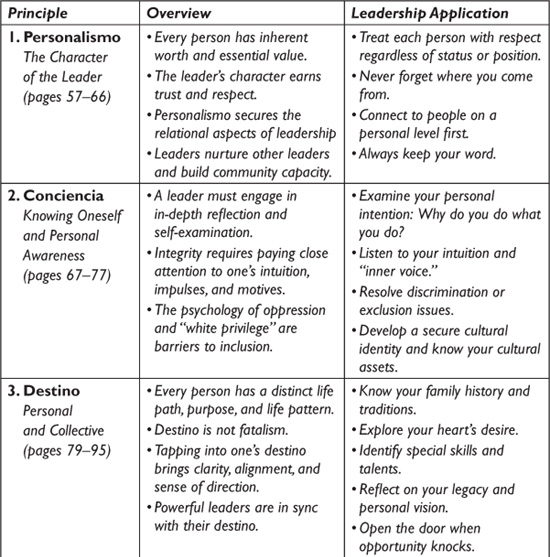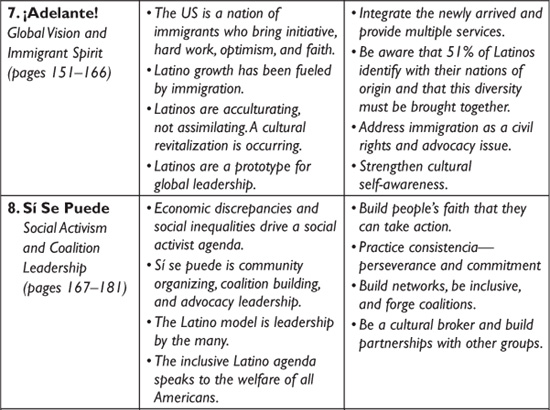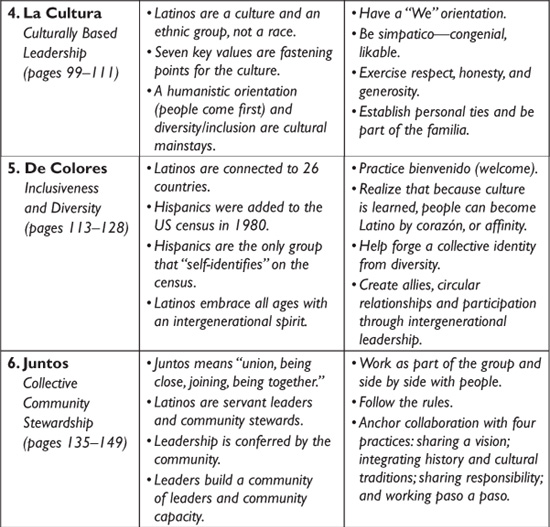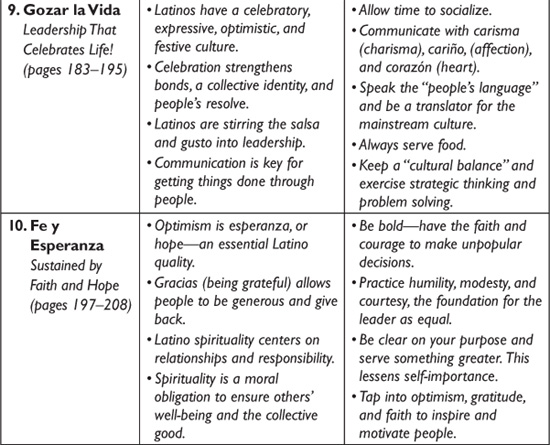INTRODUCTION
Leading Latino Style
BEYOND ITS CULTURAL INFLUENCE, Latino power will drive the American economic engine in this century. In 2017, Latinos will be the majority of the people entering the US workforce.1 They are the fast-growing small-business sector. US Latino spending power represents a trillion-dollar market and the eighth-largest gross national product in the world.2
On a more practical level, by the middle of this century, when Latinos become the dominant workforce, organizations will need to cultivate Latino talent and benefit from their dynamic work ethic. Companies who are part of the bilingual market economy will grow and prosper. The future success of organizations and businesses, then, is closely linked to the growing Latino population and market. The Power of Latino Leadership offers an exciting, hands-on, and test-driven way to connect with and leverage Latino assets, energy, and values. It puts forth ten culturally specific leadership principles rooted in Latino history and tradition.
What is important to note is that, just as women left their imprint on the twentieth century and changed every institution in their wake, so too will Latinos be the dominant force in these times. Women started the last century as 18 percent of the workforce. Today, they are a majority of workers and make up over a quarter of managers. They are the majority of students in colleges and universities, including law and medical schools. Women have made leadership more collaborative and relationship oriented.3
The Power of Latino Leadership describes how Latinos will have a similar transformative effect in this century. The book validates the leadership practices that have held Latinos together through the tribulations of being conquered, colonized, and deemed a minority. Their resiliency, contributions, and cultural vibrancy are a testament to the wisdom and perseverance of their leaders.
During the twenty-first century the Eurocentric influence of the past five hundred years will be transformed into a diverse multicultural form. Jorge Ramos, an award-winning Univision news anchor, notes that the Latinization of America is the fundamental influence that will change the monocultural nature of our society and replace ethnocentric tendencies with a multiethnic, multiracial, and multicultural nation.4 Ramos is observing that the melting pot is being converted into a delicious paella and that Latinos are a vital ingredient adding color and flavor to our emerging rainbow nation.
Part I: La Historia: Latino Fusion and Hybrid Vigor
THE POWER OF LATINO leadership begins with the complex history that birthed the Latino phenomenon. Be prepared for an exciting roller coaster ride that starts in ancient Rome, traverses the conquest of the Americas, and continues to Manifest Destiny in the nineteenth century. Why, you might ask, do we have to unearth these historical skeletons? How will this shed light on the dynamic leadership that sustained and advanced Latinos?
Well, consider that the word Latino comes from its connection to Latin America, which has its antecedent in the Roman conquest of Spain in 200 BC. Part I, “La Historia: Latino Fusion and Hybrid Vigor,” starts with the footprints of the Spanish conquistadores—one of the precursors of today’s Latinos. To understand how far we’ve come and the powerful legacy of our leaders, young Latinos must know their history. Non-Latinos will learn about the long-standing presence and contributions of Latinos in this hemisphere.
Chapter 1, “Ancient Roots and Mestizo Ancestry,” considers the racial and cultural blending in Spain that was transported to the “new world.” These antecedents resulted in a type of encounter very different from that which occurred in North America. Mestizos—the mixed-blood offspring of the Spanish and the indigenous people of this hemisphere—became the dominant population and are the ancestors of today’s Latinos. We will explore a “creation” story of the Mestizo birth almost five centuries ago that prophesied the cultural fusion that would occur and gave hope for the future.
Chapter 2, “The US Latino Legacy,” describes the annexation of the US Southwest from México and the designation of Latinos as minorities. This was abetted by Manifest Destiny in the nineteenth century, proclaiming that Indians, Blacks, and the ancestors of today’s Latinos needed to learn the ways of White civilization. Manifest Destiny swept in a belief in cultural superiority and laid the groundwork for the segregated society that continued until the civil rights movement of the 1960s.
Part II: Preparing to Lead: A Latino Perspective
BECOMING A LEADER IN the Latino community requires pondering questions such as: Why do I desire to lead? What will be my unique contribution? How will I stay on the path I have chosen? Part II offers three culturally based principles that prepare a person to become a leader and to tap into his personal power.
Chapter 3, “Personalismo: The Character of the Leader,” explores the belief that every person has inherent value and must be treated with respect. While many cultures espouse this, it is an actual expectation of Latinos, not just a cultural nicety. Personalismo prescribes that leaders establish personal, genuine, and caring relationships.
Second, the leader must become the type of person other people will follow. The essence of personalismo is the leader’s character—her persona. The leader embodies traits that earn respect and trust.
To become this type of person requires a deep connection with the leader’s inner self—the rock on which character formation rests. This implies understanding one’s roots and family heritage, staying culturally connected, and understanding history. This is discussed in chapter 4, “Conciencia: Knowing Oneself and Cultivating Personal Awareness.” A leader must also deal with the aftermath of exclusion and discrimination, both on him personally and on Latinos as a whole.
The belief that every person has a distinct life path and purpose is explored in chapter 5, “Destino: Personal and Collective Purpose.” Knowing one’s destino requires the insight of conciencia. Individualistic cultures believe a person is in charge of and determines his own future. Many Latinos believe it is impossible to control chance, fate, or unplanned events. (Having to deal with discrimination is a case in point.) Life presents certain opportunities, experiences, and challenges. Destino is a dance with the currents of life.
Part III: The Cultural Foundations of Leadership
LATINO LEADERSHIP FLOWS FROM the cultural spring. Part III considers the values that unify Latinos and their emerging collective identity.
Chapter 6, “La Cultura: Culturally Based Leadership,” looks at how the Latino culture is bound together by a common history, heritage, spiritual tradition, and language. Most importantly, the culture is integrated by shared values such as respect, honesty, service, and generosity. We will note seven key values from which culturally based leadership has emerged.
Throughout this book we will learn about Latino values through dichos (adages or proverbs). In most cultures, adages convey the important and valuable. The Anglo adage “The early bird gets the worm” advises, “Be there first and be ready to act.” “Don’t make a mountain out of a molehill” means “Take things in stride and have perspective.” Similarly, Mi casa es su casa encourages generosity and sharing. Mi casa es su casa frames leadership as service and as caring for people. It counsels leaders, “Give of your time and ideas. Be generous. Value people and tend to their needs.”
Dichos are a way for Latinos to remember the wisdom of their abuelos and understand the foundations of leadership. For non-Latinos, learning dichos invites them to increase their cultural adaptability and become Latinos by corazón.
Latinos are diversity. Their multifaceted identity and inclusiveness is reflected in “De Colores” (Of Many Colors)—a traditional song about life’s incredible diversity. In chapter 7, “De Colores: Latino Inclusiveness and Diversity,” we will learn more about this cherished song and how it invites people to be part of the culture.
“De Colores” starts with the official US census designation of Hispanics as a category in 1980. However, while the census brought together the multiple categories of “Latino,” these subgroups continue to maintain their distinct identities and nationalities. Bringing diverse communities together and building a shared identity has been the ongoing work of Latino leaders. In today’s multicultural and global community, this indispensable ability is a special contribution of Latino leadership.
Inclusiveness is also evident in the intergenerational spirit. Latinos venerate age and experience. At the same time, young people are the promise of tomorrow. This intergenerational model is even more imperative today: the 2010 US census indicated that 23 percent of children under eighteen are Hispanic.10
Part IV: Putting Leadership into Action
LATINOS ARE A WE, collective culture, where the familia and comunidad (community) take precedence over the individual. Leadership, therefore, is not driven by individual success or credit but by contributing to the group welfare. Chapter 8, “Juntos: Collective Community Stewardship,” discusses four action-oriented principles that support this process.
Juntos (we are together) signifies the collective and collaborative nature of leadership. Latino leadership is the power of many. Leaders are community stewards who promote dispersed, shared, and reciprocal power. The leader as equal—where the leader works side by side with others—facilitates people’s belief that they too can contribute. Traditionally, people power (not money, influence, or extensive resources) was the fuel for advancement.
Four practices foster community stewardship: (1) the power of a shared vision, (2) the power of history and cultural traditions, (3) compartir—the power of participation and shared responsibility, and (4) paso a paso—the power of a step-by-step approach where each success reinforces abilities and self-confidence. By linking the past, present, and future, leaders leverage the power of history and culture so that a sense of continuity and wholeness emerges.
In chapter 9, “¡Adelante! Global Vision and Immigrant Spirit,” we see how Latinos are connected through español to twenty-two countries and through a special kinship with Brazil, Portugal, Italy, and the Philippines.11 Latinos are also an integrating force of the Western Hemisphere—bridging North, South, and Central America. Moreover, in the United States there are three dominant subgroups: Mexican, Puerto Rican, and Cuban, but in the last twenty years Latino diversity has expanded. Today there are substantial populations of Dominicans, Guatemalans, Nicaraguans, and Colombians.12
These international connections make Latinos a prototype for global leadership. In 2010 over 50 percent of all US immigrants were from México and South or Central America.13 Immigration has contributed 40 percent of Latino demographic growth in the past decade.14 Immigrants seek opportunity, work hard, and bring an entrepreneurial spirit evident in the Latino workforce participation and small-business sector growth—both of which are the highest in the nation.15
Immigration presents a conundrum for Latino leaders—any organization or business experiencing a 40 percent growth must scramble to find the resources to integrate this expansion. Furthermore, leaders must constantly help the newly arrived with education, English classes, and basic services. The fair and humane treatment of immigrants remains fundamental to the Latino agenda and was evident in the Latino vote in 2012 presidential election.
Chapter 10, “Sí Se Puede: Social Activism and Coalition Leadership,” frames leadership as social activism, a natural evolution for Latinos whose concern for the community good necessitated challenging social inequities. Sí se puede! (Yes, we can!) was a rallying cry for the farm workers who marched with César Chávez in the 1960s advocating fair pay, decent working conditions, and adequate housing. Chávez was following the Latino tradition of advocacy and social action that was reignited during the civil rights movement. Dealing with immediate issues while providing the skills and knowledge to address the institutional barriers that perpetuate injustice is core to Latino leadership.
The struggle for social and economic equality has endured because of consistencia—fierce determination, commitment, and reliability. While these are widespread leadership traits, for Latinos consistencia is a lifelong commitment—an understanding that social change takes generations. Consistencia is the reason leaders put in the long hours and hard work needed for community progress. Consistencia has been the nucleus of the growing Latino power today.
Social change requires a critical mass of organized people with a unified agenda. The most powerful Latino organizations are coalitions that bring the diverse Latino groups together around a whole array of issues. Coalition leadership is sorely needed today in a divided America. Latinos offer viable models of reaching across differences, promoting partnerships, and working for the common welfare.
So how do leaders motivate people to do the hard work of community building and commit to the long-term struggle of creating a more equitable society? In chapter 11, “Gozar la Vida: Leadership That Celebrates Life,” we discover that leadership has to reflect a social, family-oriented, and celebratory nature. Check out most Latino events, and you will see music, dancing, good food, and socializing.
Gozar la vida means “to enjoy life.” For the 70 percent of Latinos who are working class, or who have dealt with discrimination, enjoying life replenishes their spirit and resolve. Since the culture prescribes that people come first, celebration strengthens relationships. What better way to enjoy people than to have a fiesta where the music is blaring and everyone contributes something?
And what do people do when they get together? Well, Latinos love animated conversation, storytelling, and expressing cariño (affection). When Latinos greet each other they give each other abrazos (embraces). They hug their leaders, too, because they have personal attachments to them.
Chapter 12, “Fe y Esperanza: Sustained by Faith and Hope,” explores the abiding faith that grounds the power of Latino leadership. How could Latinos have otherwise survived the five hundred years since the conquest of this hemisphere and kept advancing with their values and communities intact? The revered dicho Está en las manos de Dios (It’s in the hands of God) acknowledges protection and guidance on a daily basis. It anchors Latino optimism.
Faith, or fe, is a living current prescribing that people take care of one another. Leaders can tap into this sense of social responsibility and inspire the hope that by working together people can change their lives. César Chávez recognized that spirituality upheld the activist nature of leadership. “I don’t think I could base my will to struggle on cold economics or on some political doctrine,” he said. “I don’t think there would be enough to sustain me. For the basis must be faith.”16
Part V: Latino Destino
IN 2030 LATINOS WILL be one-third of our nation’s people—certainly a critical mass that can influence the twenty-first century. What are the lasting contributions Latinos will make to our country? How will they achieve this? What actions are needed to coalesce the growing numbers, for them to work with other groups, and to actualize Latino power?
Chapter 13, “Building a Diverse and Humanistic Society,” discusses how the humanistic values of the Latino culture can help create a compassionate society—one that values people and community before material wealth or individual achievement. Second, we see how, as a fusion people from many races and nations, Latinos are cultural adaptives who have the ability to connect across differences. Due to their inclusive nature, Latino leaders can help fashion a society that embraces our great diversity.
I propose that Latinos put forth an expanded definition of inclusiveness—one that leaves an open door. This final chapter invites non-Latinos to become part of the familia (with the responsibilities this entails). Non-Latinos can experience and incorporate valued aspects and become Latinos by affinity, or corazón.
And there is more good news: becoming a Latino by corazón is a springboard to experiencing other cultures, to becoming a cultural adaptive—a person who adopts beneficial behaviors, values, and reference points from a variety of cultures.
There is a hurdle to overcome, however. Historically, when White immigrants came to the United States, they were urged to assimilate. Due to racism, segregation, and exclusion, Latinos and other people of color kept their cultures and communities intact and acculturated to the mainstream. We will look at acculturation as key to becoming cultural adaptive. When mainstream leaders learn to acculturate, they can foster diversity in their organizations and in our society as well.
The final section in chapter 13 summarizes ten steps to actualize Latino power, foster a higher level of collaboration among Latino organizations, and build bridges with mainstream groups.
La Bendición
OUR VENTURE INTO LATINO history, culture, and leadership ends with an ancient spiritual tradition. When people embarked on a journey or a new stage of life, during times of change or challenge, they would ask for a bendición, or blessing, from their abuela or another respected person. This protected them and prepared them for a good outcome. The ending of this book actually heralds a new beginning: Latinos are ready to integrate their assets and unique leadership forms into the US mainstream and to create a diverse and humanistic society. As we embark on the good work of creating this noble future, a special bendición protects and guides us. We will contemplate a vision about today’s increasing multicultural people and the contribution Latinos will make to this evolution.
Latinos are becoming an influential cultural group in the United States and are already the predominant population in the Western Hemisphere. The Power of Latino Leadership will clarify and claim Latino advancement as the next positive wave of American evolution. It will propose a leadership model uniquely suited to the multicultural Latino-flavored century that is rising.
The management guru Tom Peters, addressing the National Association of American Architects, was right on when he said, “Hispanics are just wonderful. They are the next wave of people who will revitalize America … if you took away Texas, Florida, Arizona, and California, we’d lose 85 percent of our national vitality.”17 You heard it from the man! Latino destino is to revitalize and reinvigorate the American spirit. We are living proof of how embracing culture, relishing in diversity, and making a contribution to others enlivens the human spirit and enriches life. This is the essence of the growing Latino power today!
Welcome to the Latinization of the Americas.
We are all going to have a very good time!
10 Latino Leadership Principles




